Partnership Law: Assessing Violet and Sonny's Liability for Busy Bee
VerifiedAdded on 2020/04/07
|7
|2399
|158
Case Study
AI Summary
This case study examines the potential liability of Violet and Sonny to Friendly Bank regarding the Busy Bee Florist Shop. The analysis focuses on determining whether Violet and Sonny can be considered partners, thus liable for the loan. It explores the essential elements of a partnership under the Partnership Act (Vic), including carrying on a business in common for profit. The document reviews relevant legal principles, including the interpretation of 'carrying on business,' rules to decide partnership, and the implications of sharing profits. It references key cases such as Smith v Anderson, Stekel v Ellice, Cox v Hickman, and Re Ruddock to illustrate the complexities of partnership law. The analysis concludes that Violet may be considered a partner, while the situation is different for Sonny. The assignment provides a detailed legal reasoning and application of law to the facts.
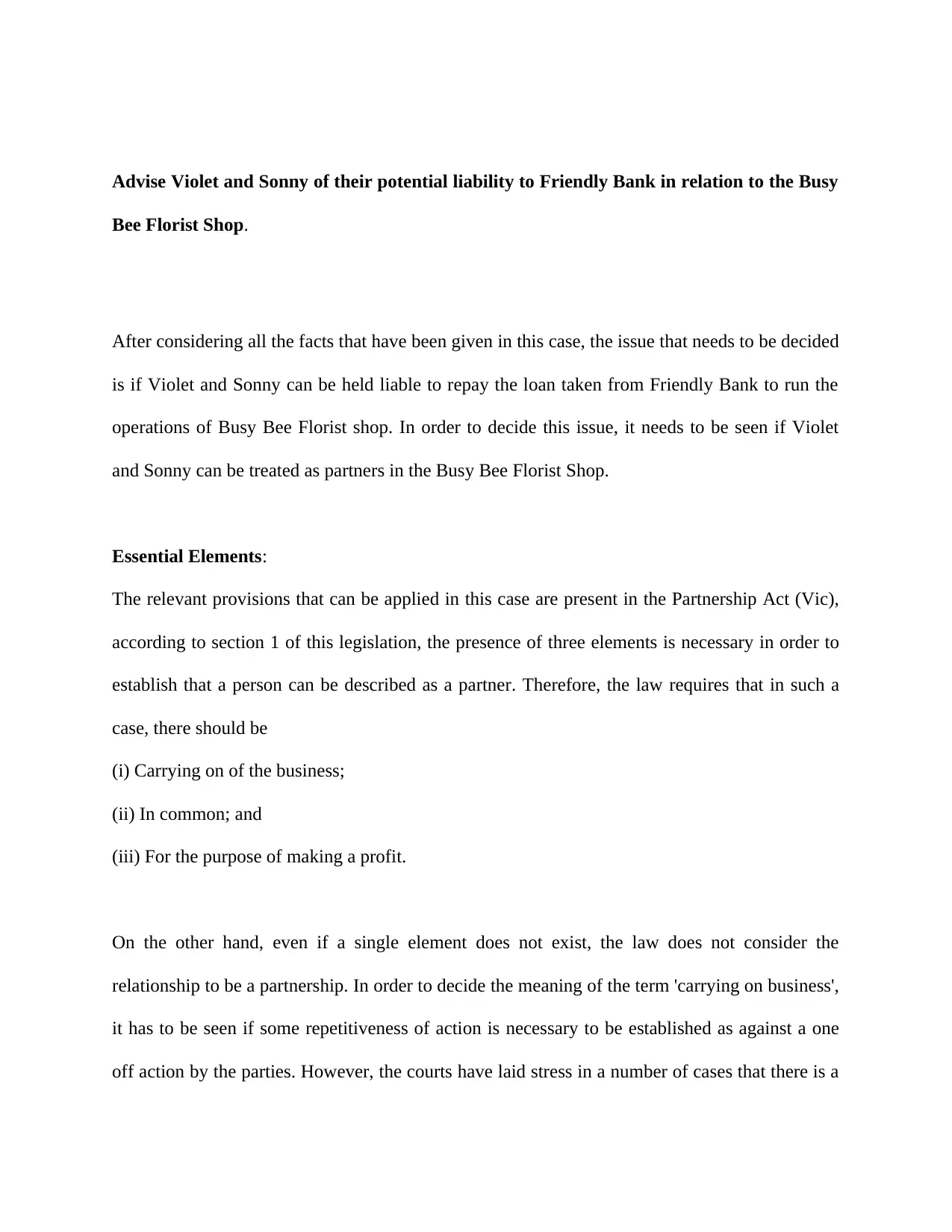
Advise Violet and Sonny of their potential liability to Friendly Bank in relation to the Busy
Bee Florist Shop.
After considering all the facts that have been given in this case, the issue that needs to be decided
is if Violet and Sonny can be held liable to repay the loan taken from Friendly Bank to run the
operations of Busy Bee Florist shop. In order to decide this issue, it needs to be seen if Violet
and Sonny can be treated as partners in the Busy Bee Florist Shop.
Essential Elements:
The relevant provisions that can be applied in this case are present in the Partnership Act (Vic),
according to section 1 of this legislation, the presence of three elements is necessary in order to
establish that a person can be described as a partner. Therefore, the law requires that in such a
case, there should be
(i) Carrying on of the business;
(ii) In common; and
(iii) For the purpose of making a profit.
On the other hand, even if a single element does not exist, the law does not consider the
relationship to be a partnership. In order to decide the meaning of the term 'carrying on business',
it has to be seen if some repetitiveness of action is necessary to be established as against a one
off action by the parties. However, the courts have laid stress in a number of cases that there is a
Bee Florist Shop.
After considering all the facts that have been given in this case, the issue that needs to be decided
is if Violet and Sonny can be held liable to repay the loan taken from Friendly Bank to run the
operations of Busy Bee Florist shop. In order to decide this issue, it needs to be seen if Violet
and Sonny can be treated as partners in the Busy Bee Florist Shop.
Essential Elements:
The relevant provisions that can be applied in this case are present in the Partnership Act (Vic),
according to section 1 of this legislation, the presence of three elements is necessary in order to
establish that a person can be described as a partner. Therefore, the law requires that in such a
case, there should be
(i) Carrying on of the business;
(ii) In common; and
(iii) For the purpose of making a profit.
On the other hand, even if a single element does not exist, the law does not consider the
relationship to be a partnership. In order to decide the meaning of the term 'carrying on business',
it has to be seen if some repetitiveness of action is necessary to be established as against a one
off action by the parties. However, the courts have laid stress in a number of cases that there is a
Paraphrase This Document
Need a fresh take? Get an instant paraphrase of this document with our AI Paraphraser
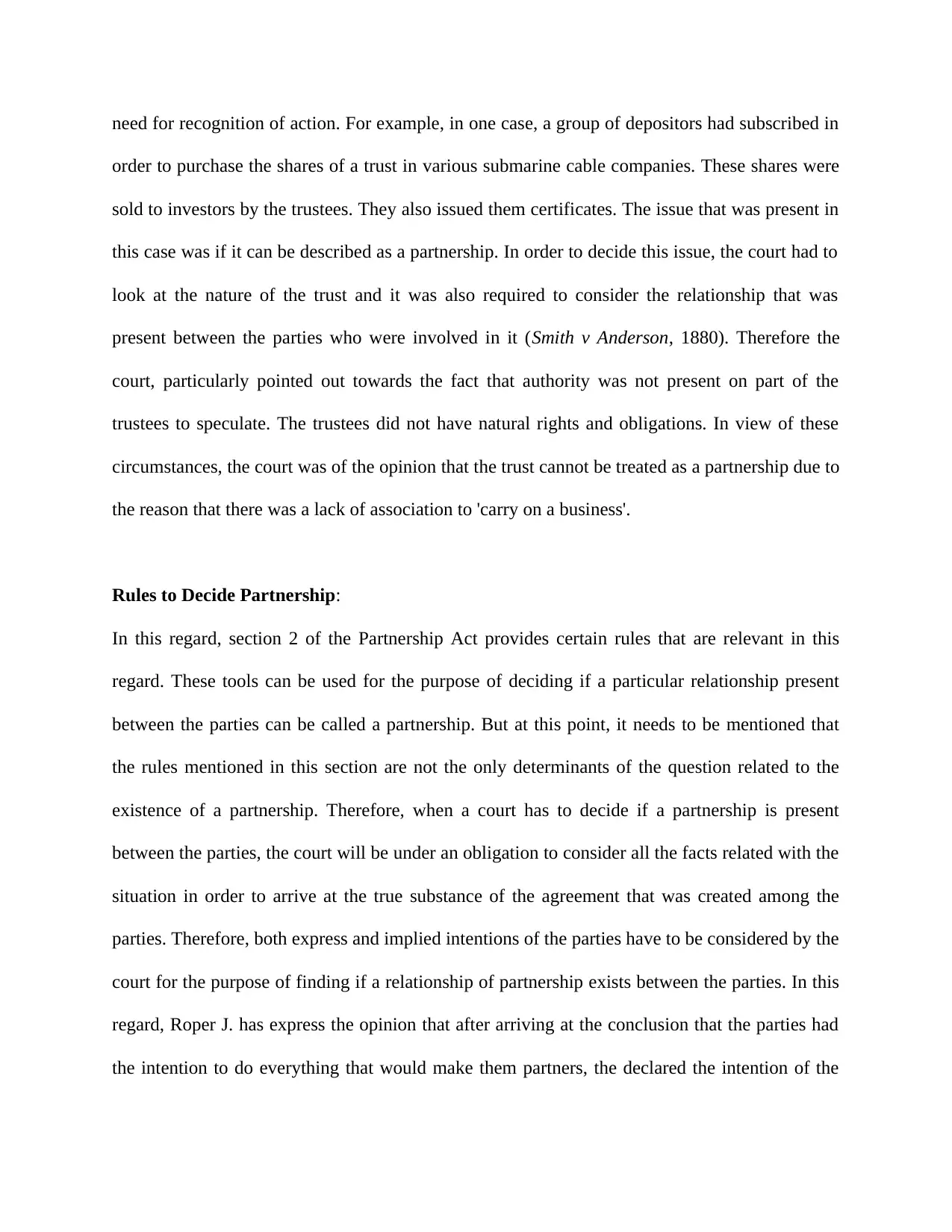
need for recognition of action. For example, in one case, a group of depositors had subscribed in
order to purchase the shares of a trust in various submarine cable companies. These shares were
sold to investors by the trustees. They also issued them certificates. The issue that was present in
this case was if it can be described as a partnership. In order to decide this issue, the court had to
look at the nature of the trust and it was also required to consider the relationship that was
present between the parties who were involved in it (Smith v Anderson, 1880). Therefore the
court, particularly pointed out towards the fact that authority was not present on part of the
trustees to speculate. The trustees did not have natural rights and obligations. In view of these
circumstances, the court was of the opinion that the trust cannot be treated as a partnership due to
the reason that there was a lack of association to 'carry on a business'.
Rules to Decide Partnership:
In this regard, section 2 of the Partnership Act provides certain rules that are relevant in this
regard. These tools can be used for the purpose of deciding if a particular relationship present
between the parties can be called a partnership. But at this point, it needs to be mentioned that
the rules mentioned in this section are not the only determinants of the question related to the
existence of a partnership. Therefore, when a court has to decide if a partnership is present
between the parties, the court will be under an obligation to consider all the facts related with the
situation in order to arrive at the true substance of the agreement that was created among the
parties. Therefore, both express and implied intentions of the parties have to be considered by the
court for the purpose of finding if a relationship of partnership exists between the parties. In this
regard, Roper J. has express the opinion that after arriving at the conclusion that the parties had
the intention to do everything that would make them partners, the declared the intention of the
order to purchase the shares of a trust in various submarine cable companies. These shares were
sold to investors by the trustees. They also issued them certificates. The issue that was present in
this case was if it can be described as a partnership. In order to decide this issue, the court had to
look at the nature of the trust and it was also required to consider the relationship that was
present between the parties who were involved in it (Smith v Anderson, 1880). Therefore the
court, particularly pointed out towards the fact that authority was not present on part of the
trustees to speculate. The trustees did not have natural rights and obligations. In view of these
circumstances, the court was of the opinion that the trust cannot be treated as a partnership due to
the reason that there was a lack of association to 'carry on a business'.
Rules to Decide Partnership:
In this regard, section 2 of the Partnership Act provides certain rules that are relevant in this
regard. These tools can be used for the purpose of deciding if a particular relationship present
between the parties can be called a partnership. But at this point, it needs to be mentioned that
the rules mentioned in this section are not the only determinants of the question related to the
existence of a partnership. Therefore, when a court has to decide if a partnership is present
between the parties, the court will be under an obligation to consider all the facts related with the
situation in order to arrive at the true substance of the agreement that was created among the
parties. Therefore, both express and implied intentions of the parties have to be considered by the
court for the purpose of finding if a relationship of partnership exists between the parties. In this
regard, Roper J. has express the opinion that after arriving at the conclusion that the parties had
the intention to do everything that would make them partners, the declared the intention of the
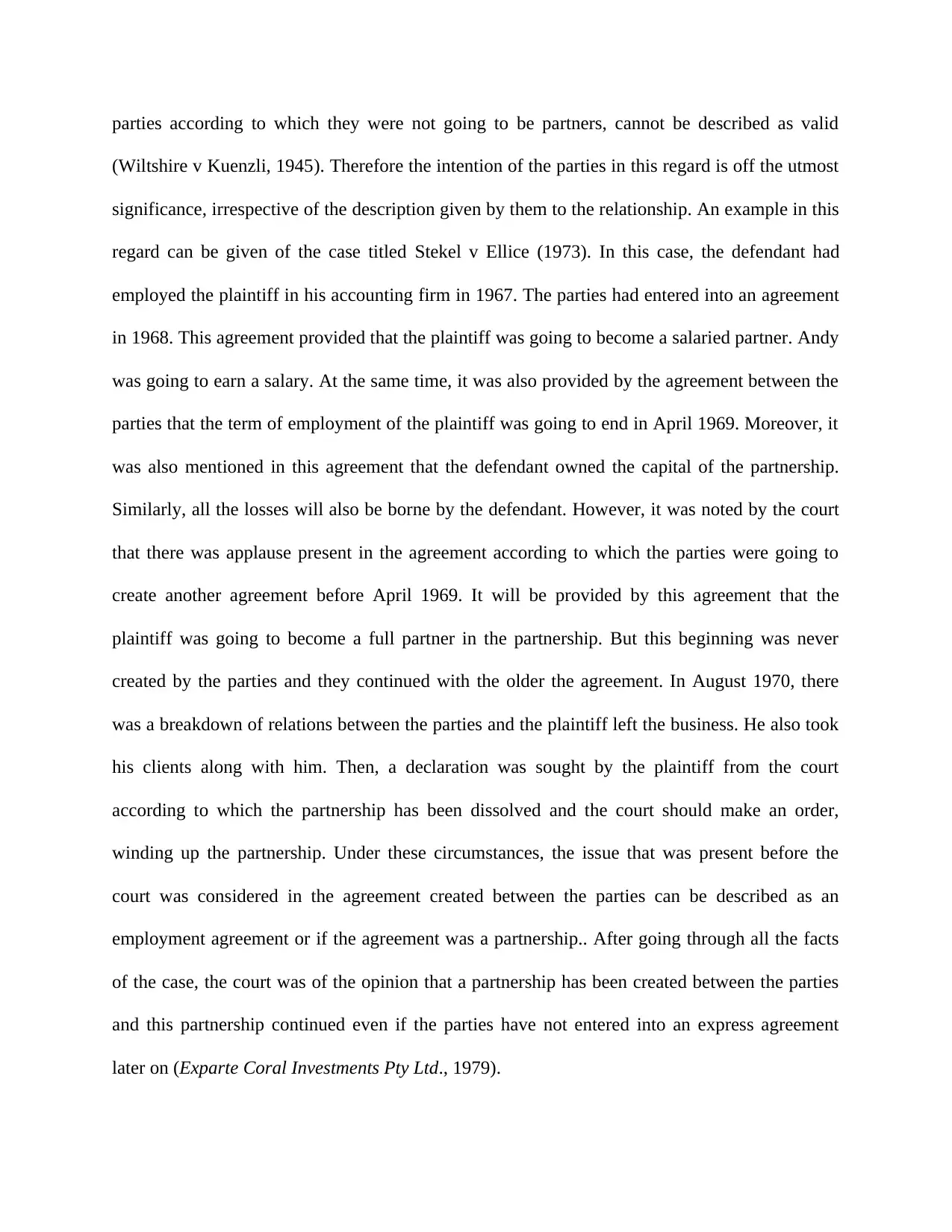
parties according to which they were not going to be partners, cannot be described as valid
(Wiltshire v Kuenzli, 1945). Therefore the intention of the parties in this regard is off the utmost
significance, irrespective of the description given by them to the relationship. An example in this
regard can be given of the case titled Stekel v Ellice (1973). In this case, the defendant had
employed the plaintiff in his accounting firm in 1967. The parties had entered into an agreement
in 1968. This agreement provided that the plaintiff was going to become a salaried partner. Andy
was going to earn a salary. At the same time, it was also provided by the agreement between the
parties that the term of employment of the plaintiff was going to end in April 1969. Moreover, it
was also mentioned in this agreement that the defendant owned the capital of the partnership.
Similarly, all the losses will also be borne by the defendant. However, it was noted by the court
that there was applause present in the agreement according to which the parties were going to
create another agreement before April 1969. It will be provided by this agreement that the
plaintiff was going to become a full partner in the partnership. But this beginning was never
created by the parties and they continued with the older the agreement. In August 1970, there
was a breakdown of relations between the parties and the plaintiff left the business. He also took
his clients along with him. Then, a declaration was sought by the plaintiff from the court
according to which the partnership has been dissolved and the court should make an order,
winding up the partnership. Under these circumstances, the issue that was present before the
court was considered in the agreement created between the parties can be described as an
employment agreement or if the agreement was a partnership.. After going through all the facts
of the case, the court was of the opinion that a partnership has been created between the parties
and this partnership continued even if the parties have not entered into an express agreement
later on (Exparte Coral Investments Pty Ltd., 1979).
(Wiltshire v Kuenzli, 1945). Therefore the intention of the parties in this regard is off the utmost
significance, irrespective of the description given by them to the relationship. An example in this
regard can be given of the case titled Stekel v Ellice (1973). In this case, the defendant had
employed the plaintiff in his accounting firm in 1967. The parties had entered into an agreement
in 1968. This agreement provided that the plaintiff was going to become a salaried partner. Andy
was going to earn a salary. At the same time, it was also provided by the agreement between the
parties that the term of employment of the plaintiff was going to end in April 1969. Moreover, it
was also mentioned in this agreement that the defendant owned the capital of the partnership.
Similarly, all the losses will also be borne by the defendant. However, it was noted by the court
that there was applause present in the agreement according to which the parties were going to
create another agreement before April 1969. It will be provided by this agreement that the
plaintiff was going to become a full partner in the partnership. But this beginning was never
created by the parties and they continued with the older the agreement. In August 1970, there
was a breakdown of relations between the parties and the plaintiff left the business. He also took
his clients along with him. Then, a declaration was sought by the plaintiff from the court
according to which the partnership has been dissolved and the court should make an order,
winding up the partnership. Under these circumstances, the issue that was present before the
court was considered in the agreement created between the parties can be described as an
employment agreement or if the agreement was a partnership.. After going through all the facts
of the case, the court was of the opinion that a partnership has been created between the parties
and this partnership continued even if the parties have not entered into an express agreement
later on (Exparte Coral Investments Pty Ltd., 1979).
⊘ This is a preview!⊘
Do you want full access?
Subscribe today to unlock all pages.

Trusted by 1+ million students worldwide
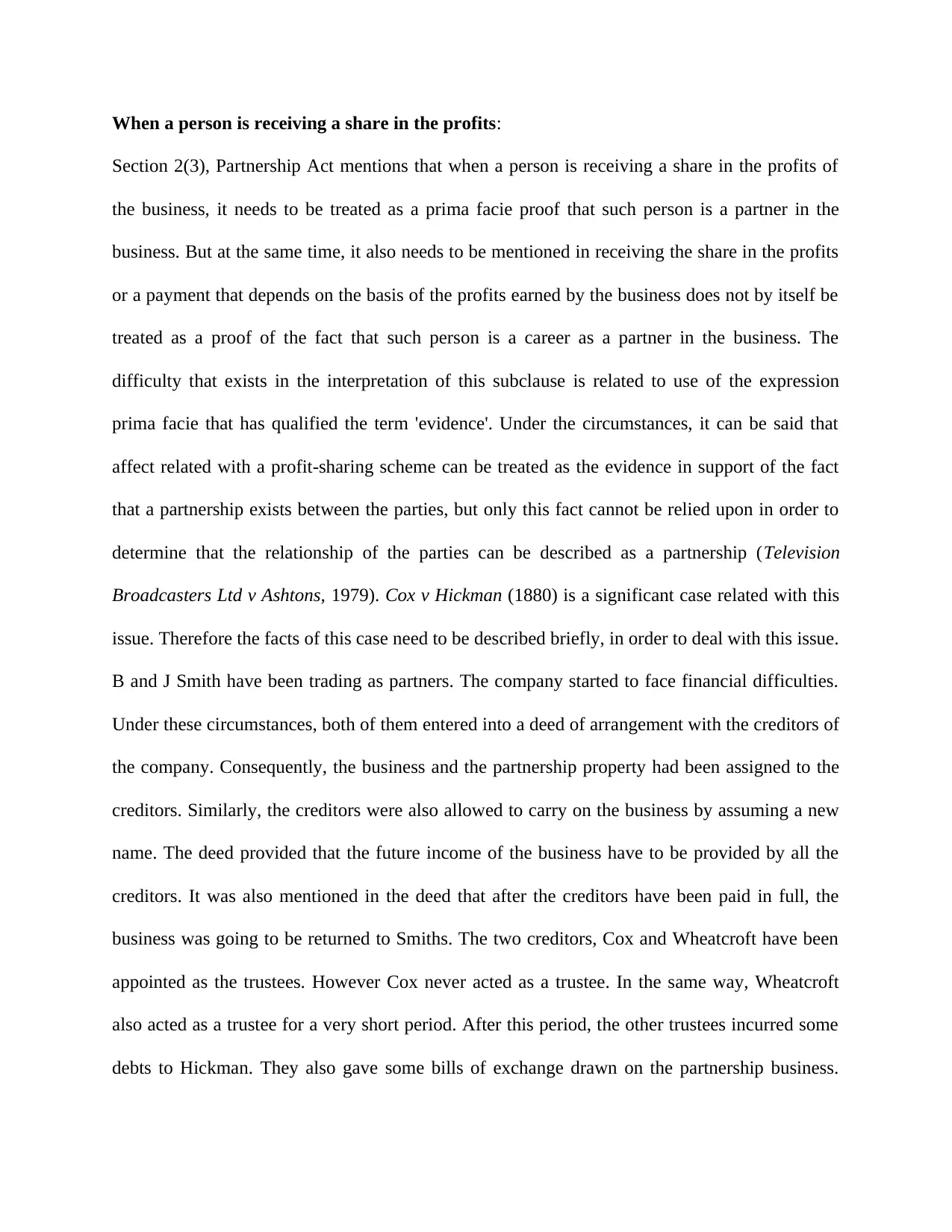
When a person is receiving a share in the profits:
Section 2(3), Partnership Act mentions that when a person is receiving a share in the profits of
the business, it needs to be treated as a prima facie proof that such person is a partner in the
business. But at the same time, it also needs to be mentioned in receiving the share in the profits
or a payment that depends on the basis of the profits earned by the business does not by itself be
treated as a proof of the fact that such person is a career as a partner in the business. The
difficulty that exists in the interpretation of this subclause is related to use of the expression
prima facie that has qualified the term 'evidence'. Under the circumstances, it can be said that
affect related with a profit-sharing scheme can be treated as the evidence in support of the fact
that a partnership exists between the parties, but only this fact cannot be relied upon in order to
determine that the relationship of the parties can be described as a partnership (Television
Broadcasters Ltd v Ashtons, 1979). Cox v Hickman (1880) is a significant case related with this
issue. Therefore the facts of this case need to be described briefly, in order to deal with this issue.
B and J Smith have been trading as partners. The company started to face financial difficulties.
Under these circumstances, both of them entered into a deed of arrangement with the creditors of
the company. Consequently, the business and the partnership property had been assigned to the
creditors. Similarly, the creditors were also allowed to carry on the business by assuming a new
name. The deed provided that the future income of the business have to be provided by all the
creditors. It was also mentioned in the deed that after the creditors have been paid in full, the
business was going to be returned to Smiths. The two creditors, Cox and Wheatcroft have been
appointed as the trustees. However Cox never acted as a trustee. In the same way, Wheatcroft
also acted as a trustee for a very short period. After this period, the other trustees incurred some
debts to Hickman. They also gave some bills of exchange drawn on the partnership business.
Section 2(3), Partnership Act mentions that when a person is receiving a share in the profits of
the business, it needs to be treated as a prima facie proof that such person is a partner in the
business. But at the same time, it also needs to be mentioned in receiving the share in the profits
or a payment that depends on the basis of the profits earned by the business does not by itself be
treated as a proof of the fact that such person is a career as a partner in the business. The
difficulty that exists in the interpretation of this subclause is related to use of the expression
prima facie that has qualified the term 'evidence'. Under the circumstances, it can be said that
affect related with a profit-sharing scheme can be treated as the evidence in support of the fact
that a partnership exists between the parties, but only this fact cannot be relied upon in order to
determine that the relationship of the parties can be described as a partnership (Television
Broadcasters Ltd v Ashtons, 1979). Cox v Hickman (1880) is a significant case related with this
issue. Therefore the facts of this case need to be described briefly, in order to deal with this issue.
B and J Smith have been trading as partners. The company started to face financial difficulties.
Under these circumstances, both of them entered into a deed of arrangement with the creditors of
the company. Consequently, the business and the partnership property had been assigned to the
creditors. Similarly, the creditors were also allowed to carry on the business by assuming a new
name. The deed provided that the future income of the business have to be provided by all the
creditors. It was also mentioned in the deed that after the creditors have been paid in full, the
business was going to be returned to Smiths. The two creditors, Cox and Wheatcroft have been
appointed as the trustees. However Cox never acted as a trustee. In the same way, Wheatcroft
also acted as a trustee for a very short period. After this period, the other trustees incurred some
debts to Hickman. They also gave some bills of exchange drawn on the partnership business.
Paraphrase This Document
Need a fresh take? Get an instant paraphrase of this document with our AI Paraphraser

Later on, Hickman wanted and established the liability of Cox and Wheatcroft regarding these
bills. However, the court arrived at the conclusion that in this case Cox and Wheatcroft cannot be
considered as partners. The court noted the fact that there was no knowledge present on part of
Hickman regarding the deed of arrangement. Under these circumstances, Cox and Wheatcroft
were allowed by the court to deny the liability although the arrangement provided that they were
going to share the profits of the business. In this regard, it was stated by the court that only this
fact cannot be treated as being sufficient to describe both of them as partners. Therefore, in his
decision, the court was of the opinion that the arrangement which provided that the future profits
of the business have to be applied in order to pay the old debts and the decision made by the
creditors to give up their right to be paid from the capital of the business, does not appear to be a
partnership with other parties who do not have any knowledge of the deed.
It was held by the court that although the person sharing the profits can be described as a partner
but this does not apply in all the cases. For this purpose, the sense in which the term 'sharing the
profits' has been used, needs to be considered. For instance, in the present case, the court had
doubts if the creditors of the governing who were going to receive only the payment of their debt
out of the profits of the business, can be said to be sharing the profits. As a result, this opinion is
treated as a general rule. Section 2(3) (a) to (e) of the Act mentioned the cases where the above-
mentioned resolution cannot be made. Hence, according to the law, receipt of debt on the
liquidated demand made by a person out of the profits of the business does not in itself makes
such a person, a partner. This rule is based on Cox v Hickman (1860). But at the same time, it has
also been provided by the laws that if the circumstances are present, which indicate towards the
fact that the relationship was a partnership, in such a case, the lender can be considered a partner,
regardless of their intentions (Re Ruddock, 1879).
bills. However, the court arrived at the conclusion that in this case Cox and Wheatcroft cannot be
considered as partners. The court noted the fact that there was no knowledge present on part of
Hickman regarding the deed of arrangement. Under these circumstances, Cox and Wheatcroft
were allowed by the court to deny the liability although the arrangement provided that they were
going to share the profits of the business. In this regard, it was stated by the court that only this
fact cannot be treated as being sufficient to describe both of them as partners. Therefore, in his
decision, the court was of the opinion that the arrangement which provided that the future profits
of the business have to be applied in order to pay the old debts and the decision made by the
creditors to give up their right to be paid from the capital of the business, does not appear to be a
partnership with other parties who do not have any knowledge of the deed.
It was held by the court that although the person sharing the profits can be described as a partner
but this does not apply in all the cases. For this purpose, the sense in which the term 'sharing the
profits' has been used, needs to be considered. For instance, in the present case, the court had
doubts if the creditors of the governing who were going to receive only the payment of their debt
out of the profits of the business, can be said to be sharing the profits. As a result, this opinion is
treated as a general rule. Section 2(3) (a) to (e) of the Act mentioned the cases where the above-
mentioned resolution cannot be made. Hence, according to the law, receipt of debt on the
liquidated demand made by a person out of the profits of the business does not in itself makes
such a person, a partner. This rule is based on Cox v Hickman (1860). But at the same time, it has
also been provided by the laws that if the circumstances are present, which indicate towards the
fact that the relationship was a partnership, in such a case, the lender can be considered a partner,
regardless of their intentions (Re Ruddock, 1879).

After going through the legal position mentioned above as well as the rules that apply to the facts
of the present case, it can also be concluded in this case that Violet can be treated as a
partnership in Busy Bee Florist Shop although the agreement concluded between the parties has
stated that the lender (Violet) is not going to be a partnership in the business. But the situation is
different in case of Sonny. In this case, it cannot be said the Sonny is also a partner in the
business. The reason is that according to the law even if the fact that the person is receiving a
share out of the profits of the business has to be treated as the prima facie evidence regarding the
fact that the person is acting as a partner but only on the basis of this fact, it cannot be concluded
that such a person is a partner in the business (Badeley v Consolidated Bank (1888). In such
cases, the law provides that the contract for remuneration that is going to be provided to a servant
or an agent in the form of a share, from the profits of the business does not in itself make the
person, a partner in the business and as a result, liable for the obligations of the business.
Therefore, on the application of the above-mentioned legal rules to the effects of the present
instrument can be concluded in this case that Violet needs to be treated as a partner in Busy Bee
Florist Shop. As mentioned above, the viability of the partners is joint and several. Therefore, the
law allows Friendly Bank to recover their pending amount from Violet. On the other hand, it
cannot be said that Sonny is also a partner in the business. As a result, Friendly Bank cannot
initiate action against Sonny for the recovery of the amount that was owed by Busy Bee Florist
Shop.
of the present case, it can also be concluded in this case that Violet can be treated as a
partnership in Busy Bee Florist Shop although the agreement concluded between the parties has
stated that the lender (Violet) is not going to be a partnership in the business. But the situation is
different in case of Sonny. In this case, it cannot be said the Sonny is also a partner in the
business. The reason is that according to the law even if the fact that the person is receiving a
share out of the profits of the business has to be treated as the prima facie evidence regarding the
fact that the person is acting as a partner but only on the basis of this fact, it cannot be concluded
that such a person is a partner in the business (Badeley v Consolidated Bank (1888). In such
cases, the law provides that the contract for remuneration that is going to be provided to a servant
or an agent in the form of a share, from the profits of the business does not in itself make the
person, a partner in the business and as a result, liable for the obligations of the business.
Therefore, on the application of the above-mentioned legal rules to the effects of the present
instrument can be concluded in this case that Violet needs to be treated as a partner in Busy Bee
Florist Shop. As mentioned above, the viability of the partners is joint and several. Therefore, the
law allows Friendly Bank to recover their pending amount from Violet. On the other hand, it
cannot be said that Sonny is also a partner in the business. As a result, Friendly Bank cannot
initiate action against Sonny for the recovery of the amount that was owed by Busy Bee Florist
Shop.
⊘ This is a preview!⊘
Do you want full access?
Subscribe today to unlock all pages.

Trusted by 1+ million students worldwide
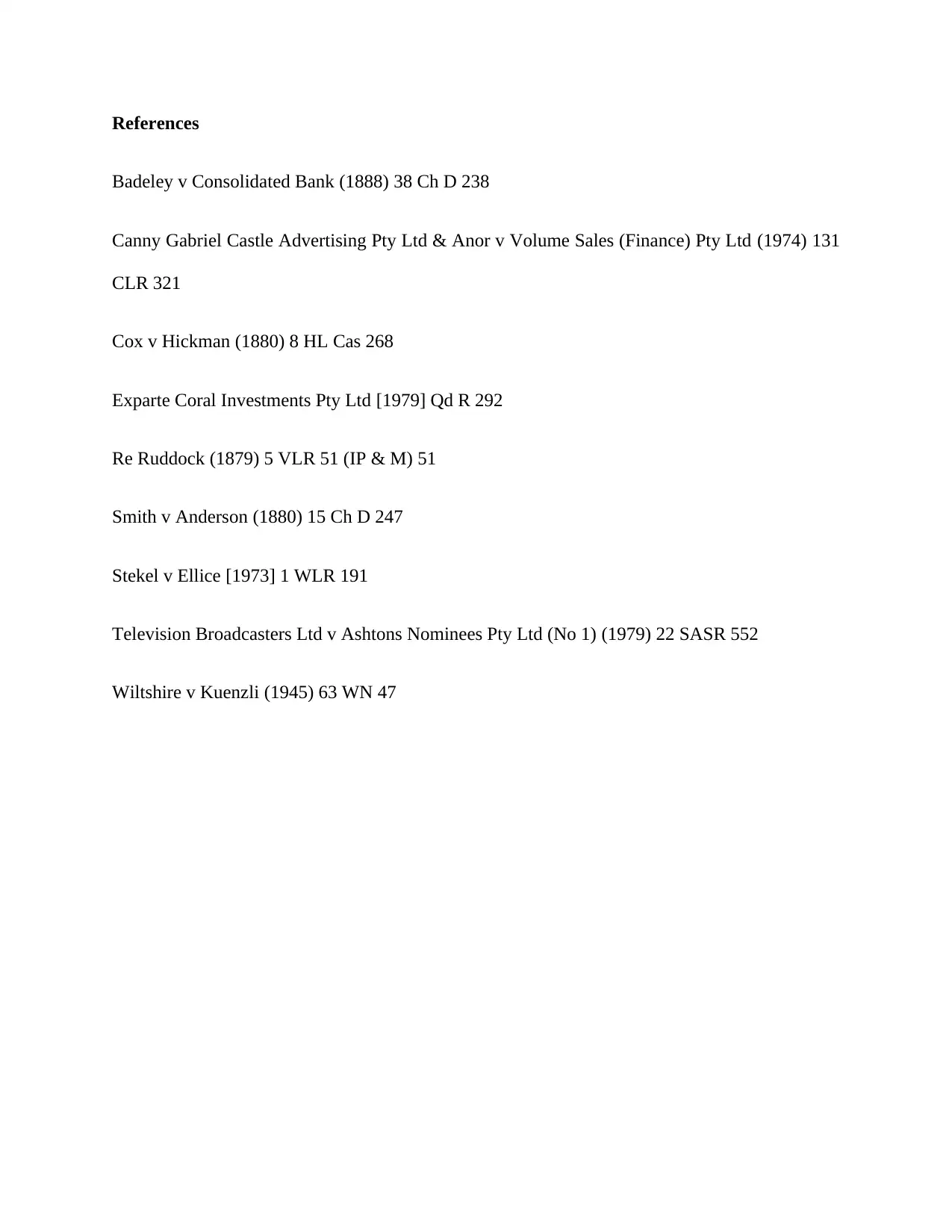
References
Badeley v Consolidated Bank (1888) 38 Ch D 238
Canny Gabriel Castle Advertising Pty Ltd & Anor v Volume Sales (Finance) Pty Ltd (1974) 131
CLR 321
Cox v Hickman (1880) 8 HL Cas 268
Exparte Coral Investments Pty Ltd [1979] Qd R 292
Re Ruddock (1879) 5 VLR 51 (IP & M) 51
Smith v Anderson (1880) 15 Ch D 247
Stekel v Ellice [1973] 1 WLR 191
Television Broadcasters Ltd v Ashtons Nominees Pty Ltd (No 1) (1979) 22 SASR 552
Wiltshire v Kuenzli (1945) 63 WN 47
Badeley v Consolidated Bank (1888) 38 Ch D 238
Canny Gabriel Castle Advertising Pty Ltd & Anor v Volume Sales (Finance) Pty Ltd (1974) 131
CLR 321
Cox v Hickman (1880) 8 HL Cas 268
Exparte Coral Investments Pty Ltd [1979] Qd R 292
Re Ruddock (1879) 5 VLR 51 (IP & M) 51
Smith v Anderson (1880) 15 Ch D 247
Stekel v Ellice [1973] 1 WLR 191
Television Broadcasters Ltd v Ashtons Nominees Pty Ltd (No 1) (1979) 22 SASR 552
Wiltshire v Kuenzli (1945) 63 WN 47
1 out of 7
Related Documents
Your All-in-One AI-Powered Toolkit for Academic Success.
+13062052269
info@desklib.com
Available 24*7 on WhatsApp / Email
![[object Object]](/_next/static/media/star-bottom.7253800d.svg)
Unlock your academic potential
Copyright © 2020–2025 A2Z Services. All Rights Reserved. Developed and managed by ZUCOL.





